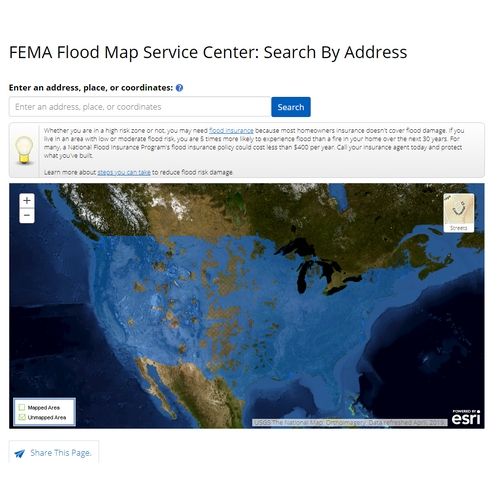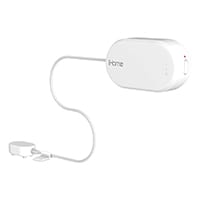If you’ve ever seen a birds-eye view of your neighborhood from a satellite image, the layout may seem random. But lay a flood zone map over that view, and those curving streets and areas of wilderness make more sense.
Here are some steps you can take to evaluate the flood risk your home faces—and protect against it.
How to tell if you're in a flood zone—and what to do about it
What is a flood zone?
Check the FEMA flood map
The Federal Emergency Management Agency, or FEMA, has a tool that makes it easy to see if your address is in a flood zone. The Flood Map Service Center shows information like flood zones, floodways, and your home’s risk level.
There’s also topographical and infrastructural information about features like levees, coastal barriers, and the base flood line. At first, the map may not make much sense, but it’s easier to read than it seems.
How to use the FEMA flood map
The map shows overlays of specific floodplains and the risk around your property. You might say labels such as, “Area of Minimal Flood Hazard,” or “0.2 PCT Annual Chance of Flood Hazard.”
Fortunately, you don’t have to figure out what that means on your own. FEMA provides a glossary to help you decode some of the more confusing terms.
When you examine the flood map, some of the labels may seem dated. These dates just refer to when the map was officially adopted by your area. You can toggle these dates on and off or check out the Dynamic Map to see updated versions.
Understanding flood zones
Flood zones are labeled alphabetically (Zone A, Zone B, etc.). These labels are primarily used by insurers to help determine flood risk and set flood insurance rates and terms. Here’s a quick rundown of what the most common flood zones mean for you and your house.
- Zone A: This is the most common flood zone, and there are five types of Zone A floodplains. If you live in a Zone A flood zone, it means you’re in a special flood hazard area that’s not coastal. The type of Zone A that applies to your home will impact your flood insurance premium.
- Zone B: Homes in Zone B face a moderate flood hazard risk.
- Zone C: Homes in Zone C face a minimal flood hazard risk.
- Zone D: This zone indicates a possible risk of flooding, but the hazard level is undetermined.
- Zone V: This is a special flood hazard area with high risk for floods in coastal areas.
- Zone X: On newer flood insurance rate maps, Zones B and C are identified as Zone X.
Keep track of changes
With new construction and changes in topography, floodplains and flood zone designations can change over time. Make a plan to check for changes in your property’s flood zone designation every five years or so.
Keeping an eye on your flood zone designation not only makes you better prepared for a possible flood, but it also ensures that you always have the right type and amount of flood insurance.
Expert tip
Look into flood insurance
If you live in a flood zone, the next thing to do is find out if you have flood insurance. While floods are much more common fires, most homeowners policies don’t cover flood damage.2
Flood insurance policies are available through private carriers, but you can also opt for government-sponsored coverage through the National Flood Insurance Program (NFIP).
Flood insurance costs between $200 and $800 a year, but the NFIP has ways that you can lower that cost by better protecting your home against flooding. Visit FloodSmart.gov to learn more about the NFIP and how you can pay less for flood insurance.
Use flood sensors
There are several ways to prevent your home from flooding. One of them is using a flood sensor, devices that notify you of water leaks.
These sensors detect leaks from appliances like your water heater and washing machine, and can also alert you to weather-related leaks in the basement.
You can also look into adding flood sensors to your home security system. This way you’re sure to get an alert if sny unwanted water shows up in your home.
FAQ
Are sellers legally required to disclose if a house is in a flood zone or if it’s had flood damage in the past?
No, they’re not. Federal laws don’t require sellers or agents to disclose any previous flooding on a property when it’s up for sale.
It’s up to you as a buyer to find out the property’s history—but keep in mind that even if you don’t, your mortgage company will, and a flood zone designation could impact your ability to get financing.
You don’t want any surprises when it’s time to get a mortgage for your new home, so do the research before you make an offer.
Can I still get a mortgage on my property without flood insurance?
Maybe—it depends on its flood zone designation. Properties in flood zones with a higher risk factor usually require flood insurance for a mortgage.
Your house is your collateral for your home loan, and if it’s destroyed in a flood, your mortgage company stands to take a financial hit, so flood insurance is pretty important to lenders.
My area only has a 1% chance of flooding—so why is it still considered a flood hazard zone?
Floods are a rare occurrence, even for areas with high risk, like waterfront properties and coastal areas. A one percent chance of flooding means that your area is expected to get a devastating flood once every 100 years.
While that may not seem like a huge risk, it’s pretty high, considering the fact that an entire geographical area could be wiped out. A one percent risk should be taken seriously, especially since you don’t know where you are in that 100-year cycle.
Will having a house in a flood zone make it harder to sell later on?
Possibly, but having flood insurance on the property can help, because that way, potential buyers will know their options for insuring the home. You can also take proactive steps to protect your home against floods, like elevating it or taking other measures to make your home more flood-resistant.
Read FEMA’s Reducing Flood Risk to Residential Buildings that Cannot Be Elevated to learn more about how you can better protect your home.
Sources:
1. FEMA, “Flood Zones,” July 2020. Accessed September 4, 2020.
2. FEMA, “FEMA Flood Map Service Center.” Accessed September 4, 2020.
The post How to Know If You Live in a Flood Zone appeared first on SafeWise.



No comments:
Post a Comment